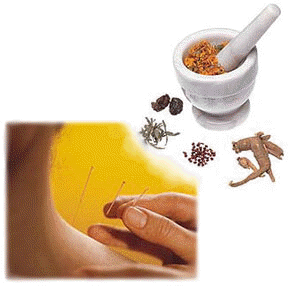 |

Visiting
a Chinese pharmacy to get Chinese medicine in Taiwan is much like being inside a miniature museum of
natural science. Tucked away in row after row of tidy drawers are animal, plant,
and mineral products, each with a particular purpose of making Chinese medicine. Among the assortment of
curiosities is amber, to relax the nerves; peach pits and safflower, to improve
blood circulation; Chinese ephedra (mahuang) to induce perspiration; and ginseng
to strengthen cardiac function.
The filling of a prescription ordered by a
Chinese doctor is a fascinating process to watch. The pharmacist selects a few
particular ingredients from the hundreds on his shelf. Chinese medicine are taken home by
the patient, boiled into a "soup", and drunk. Confronted with such a steaming
brew, you might ask yourself just what the basis of this ancient medical art is.
The theoretical framework of Chinese
medicine was established more than two millennia ago. A great deal of ancient
medical knowledge is preserved in the pre-Chin (221-207 B.C.) Inner Cannon (Nei
Ching), a comprehensive record of Chinese medicine and medical theories up to that time. The
Han dynasty (206 B.C.-220 A.D.) produced an authoritative and valuable practical
guide--even to the present day--to the treatment of illness, the Treatise on
Diseases Caused by Cold Factors (Shang Han Lun) by Chang Chung-ching.
One of the best-known Chinese medical
works is the Materia Medica(Pen Ts'ao Kang Mu), compiled in the Ming dynasty
(1368-1644 A.D.) by Li Shih-chen. This encyclopedic work heralded a new era in the world history of pharmacology; it includes
descriptions of 1,892 different kinds of Chinese medicines. These works have all been
translated into several foreign languages, and have exercised a profound
influence on East Asian and European countries.
heralded a new era in the world history of pharmacology; it includes
descriptions of 1,892 different kinds of Chinese medicines. These works have all been
translated into several foreign languages, and have exercised a profound
influence on East Asian and European countries.
The Chinese have a unique system of
categorizing illnesses that is widely divergent from its Western counterpart.
The philosophy behind Chinese medicine is that man lives between heaven and
earth, and comprises a miniature universe in himself. The material of which
living things are made is considered to belong to the "yin", or female, passive,
receding aspect of nature. The life functions of living things, on the other
hand, are considered to belong to the "yang", or masculine, active, advancing
aspect. The functions of living beings are described in terms of the following
five centers of the body: 1."heart" or "mind" (hsin); this refers to the
"command center" of the body, which manifests itself as consciousness and
intelligence; 2."lungs" or "respiratory system" (fei); this system regulates
various intrinsic functions of the body, and maintains cybernetic balance;
3."liver" (kan); this term includes the limbs and trunk, the mechanism for
emotional response to the external environment, and the action of organs;
4."spleen" (p'i); this organ system regulates the distribution of nutrition
throughout the body, and the metabolism, bringing strength and vigor to the
physical body; and 5."kidneys" (shen); this refers to the system for regulating
the storage of nutrition and the use of energy; the human life force depends on
this system. This theory is used to describe the system of body functions, and
as a whole is referred to as the "latent phenomena" ( ts'ang hsiang).
The passage of the seasons and changes in
the weather can have an influence on the human body. Those having the most
pronounced effect are wind (feng), cold (han), heat (shu), moisture (shih),
dryness (tsao), and internal heat (huo "fire"). Excessive or extraordinary
changes in the weather harm the body, and are referred to as the "six external
disease-causing factors" (liu yin). On the other hand, if mood changes within
the individual, such as happiness(hsi), anger(nu), worry(yu), pensiveness(szu),
grief(pei), fear(k'ung), and surprise(ching) are too extreme, they will also
harm the health. These emotions are called the "seven emotions"(ch'i ch'ing). In
Chinese medicine, the six external disease-causing factors, interacting with the
seven emotions, form the theoretical foundation of disease pathology. These
theoretical models, coupled with the "theory of latent phenomena," are used to
analyze the patient's constitution and his illness, and diagnose the exact
nature of his overall physical and psychological loss of balance. Based on this
analysis, the doctor can prescribe a method to correct the imbalance. The object
of Chinese medicine is the person, not just the illness. In Chinese medical
thinking, illness is only one manifestation of an imbalance that exists in the
entire person.
Next Page
|
 |



 heralded a new era in the world history of pharmacology; it includes
descriptions of 1,892 different kinds of Chinese medicines. These works have all been
translated into several foreign languages, and have exercised a profound
influence on East Asian and European countries.
heralded a new era in the world history of pharmacology; it includes
descriptions of 1,892 different kinds of Chinese medicines. These works have all been
translated into several foreign languages, and have exercised a profound
influence on East Asian and European countries.